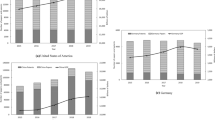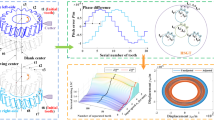Abstract
Some special compact mechanical transmissions with multi-load are required in robot joints, artillery systems, agricultural machinery and multirole shaft-driving devices, but the existing products of mechanical transmissions cannot meet the demand of modern industry, and need some new transmission structure or solution. To this end a novel worm gear named the planar enveloping internal-meshing worm drive is proposed for applications requiring multi-load transmission for the first time. Its meshing functions, including the induced normal curvature, lubrication angle, and relative entrainment velocity, are developed on basis of gear meshing theory. Furthermore, the meshing zone for the worm tooth is analyzed through tooth contact analysis in order to determine the optimal mother plane dip angle β. Moreover, the tooth profile of the worm wheel is optimized and the worm parameters obtained through tooth contact analysis is verified. Finally, the worm gear is manufactured by using the 3D-printing technology to measure the correction for the theory investigation. The presented worm drive exhibits ideal meshing performance, with minor contact stress and high lubrication. This gear set is expected to find applications in such systems as robot joints, artillery systems, and multi-roller shaft-driving devices.











Similar content being viewed by others
References
Simon V (2008) Influence of tooth errors and misalignments on tooth contact in spiral bevel gears. Mech Mach Theory. 43(10):1253–1267
Dudás L (2012) Modelling and simulation of a new worm gear drive having point-like contact. Eng Comput 29(3):251–272
Medvedev VI, Volkov AE, Volosova MA et al (2015) Mathematical model and algorithm for contact stress analysis of gears with multi pair contact. Mech Mach Theory 86:1561–1571
Xu Y, Gao F, Pan Y et al (2016) Method for Six-Legged robot stepping on obstacles by indirect force estimation. Chin J Mech Eng (Engl Ed) 29(4):669–679
Deng X, Wang J, Horstemeyer MF et al (2012) Parametric study of meshing characteristics with respect to different meshing rollers of the antibacklash double-roller enveloping worm gear. J Mech Des 134(8):081004-1–081004-12
Deng X, Wang J, Wang J et al (2015) Parametric analysis of the end face engagement worm gear. Chin J Mech Eng (Engl ed) 28(6):1177–1185
Litvin FL, Fuentes AF (2004) Gear geometry and applied theory, vol 30(3). Cambridge University Press, Cambridge, p 493
Deng X, Wang J, Horstemeyer MF et al (2013) Modification design method for an enveloping hourglass worm with consideration of machining and misalignment errors. Chin J Mech Eng (Engl ed) 26(5):948–956
Fujisawa Y, Komori M (2015) Surface finishing method for tooth flank of heat-treated surface-hardened small gears using a gear-shaped tool composed of alumina-fiber-reinforced plastic. Precis Eng 39(3):234–242
Golabi S, Fesharaki J, Yazdipoor M (2014) Gear train optimization based on minimum volume/weight design. Mech Mach Theory 73(2):197–217
Wansung LIN, Yipei SHIH, Jyhjone LEE (2014) Design of a two-stage cycloidal gear reducer with tooth modifications. Mech Mach Theory 79(5):184–197
Shuting LI (2014) Design and strength analysis methods of the trochoidal gear reducers. Mech Mach Theory 81(7):140–154
Litvin F, Fuentes A, Hayasaka K (2006) Design, manufacture, stress analysis, and experimental tests of low-noise high endurance spiral bevel gears. Mech Mach Theory 41(1):83–118
Tunalioğlu MŞ, Tuç B (2014) Theoretical and experimental investigation of wear in internal gears. Wear 309(1):208–215
Deng XQ, Zhu WB, Chen YH, Chen SA, Wang JG (2017) Optimal design for an end face engagement worm gear with multiple worm-wheel meshing. Chin J Mech Eng (Engl Ed) 30(1):144–151
Zheng L, Deng X, Wang JG, Yin G (2017) Study on the roller enveloping end face internal engagement worm gear. J Braz Soc Mech Sci Eng 39(7):2701–2711
Acknowledgements
This work was supported by the National Natural Science Foundation of China (Grant 51305356 and 51575456) and the Spring Sunshine Plan of the Ministry of Education of China (Grant 14202505).
Author information
Authors and Affiliations
Corresponding author
Ethics declarations
Conflict of interest
There are no conflicts of interest.
Additional information
Techncial Edtior: Fernando Antonio Forcellini.
Rights and permissions
About this article
Cite this article
Deng, X., Feng, Z. Theory study of a novel planar enveloping internal-meshing worm drive. J Braz. Soc. Mech. Sci. Eng. 39, 4807–4818 (2017). https://doi.org/10.1007/s40430-017-0909-3
Received:
Accepted:
Published:
Issue Date:
DOI: https://doi.org/10.1007/s40430-017-0909-3




